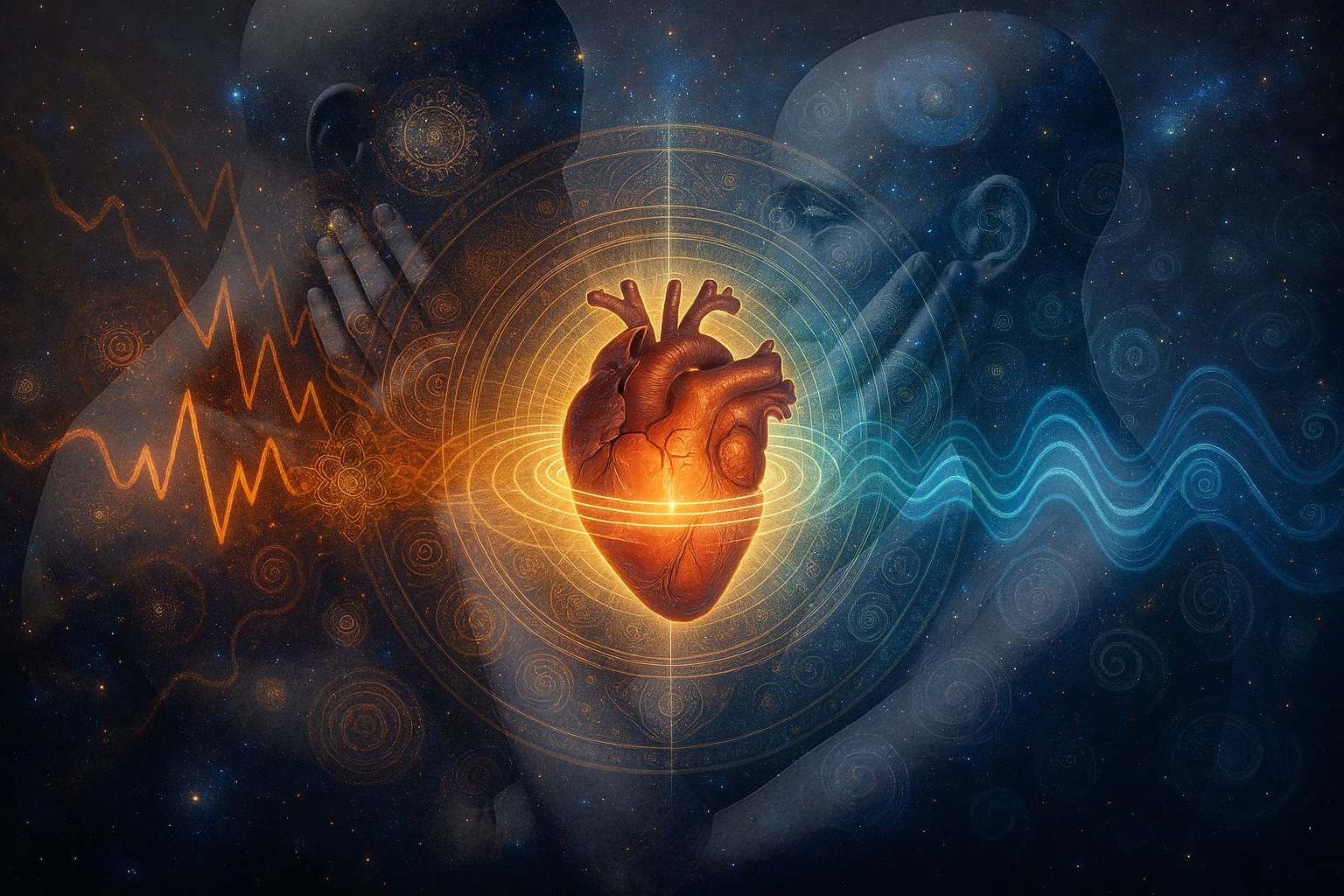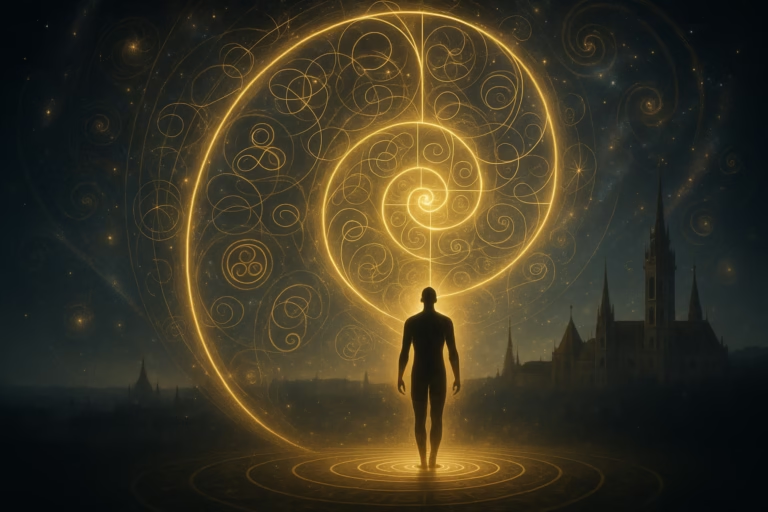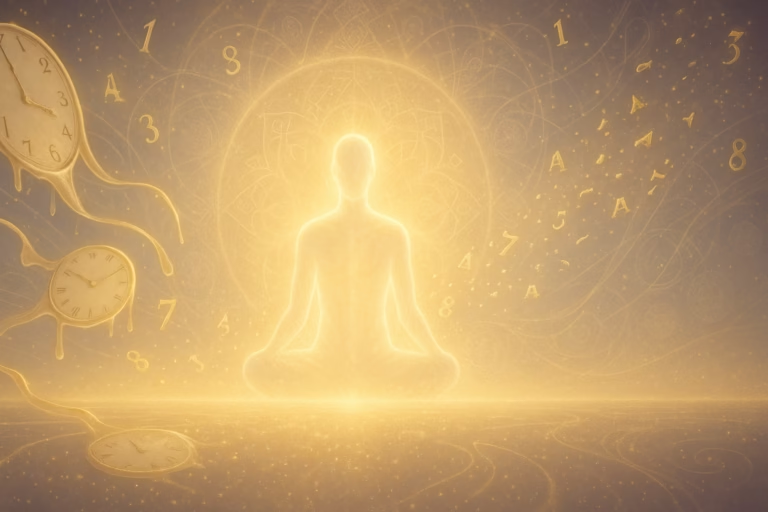PODCAST: The Cosmic Role of Human Emotion
The prevailing scientific view of human emotion often frames it as a purely internal, biological affair—a complex interplay of neurotransmitters, hormonal cascades, and neural firing patterns confined within the body’s physical boundaries. We experience the rush of love, the ache of sorrow, and the fire of anger as deeply personal, private sensations. But what if this perspective is incomplete? What if our emotions are not merely reactions to the universe but are, in some profound way, active participants in its unfolding? This exploration delves into a radical hypothesis: that human emotions might act as tangible forces, ripples that extend beyond our individual consciousness to influence reality itself. The journey begins with the bedrock of established science, ventures into the speculative frontiers of bioenergetics and quantum theory, and ultimately finds resonance in the timeless wisdom of ancient traditions.
The Inner Mechanics of Feeling: A Scientific Foundation
To understand the potential cosmic role of emotion, it is essential to first ground the discussion in its physical reality. Emotions are not abstract; they are intrinsically linked to physiological processes, a truth that becomes clear upon examining the body’s remarkable internal communication systems.
The conventional model of a hierarchical brain controlling a passive body is being superseded by a more nuanced understanding of the heart-brain connection. While the brain does indeed regulate the heart through the sympathetic and parasympathetic branches of the autonomic nervous system 1, a significant body of research reveals a profound bidirectional communication. The heart possesses its own complex intrinsic nervous system—a “little brain” containing approximately 40,000 neurons.2 This intricate network is sophisticated enough to operate independently of the cranial brain, enabling the heart to learn, remember, and even process sensations.2
Perhaps most notably, the heart sends more signals to the brain than the brain sends to the heart. These afferent nerve pathways cascade up into the higher centers of the brain, where they can either inhibit or facilitate the brain’s electrical activity.2 This physiological reality fundamentally re-positions the heart from a simple pump to an intelligent, active organ that profoundly influences cognitive functions, perception, and decision-making. The quality of the heart’s signals dictates the quality of the brain’s performance, shifting the model from a simple hierarchy to a dynamic, interwoven feedback loop where the state of one profoundly influences the other.
The experience of emotions is also a meticulously choreographed neurochemical event, a symphony of hormones and neurotransmitters. The “intoxicating rush” often associated with love and connection is not just a poetic expression; it is the result of a surge of key neurochemicals. Dopamine, the “feel-good” neurotransmitter, activates the brain’s reward system, creating a sense of pleasure and motivation.4 This reinforces the desire to seek more of these feelings, a phenomenon that has been likened to the effects of addictive substances.4 Meanwhile, oxytocin, the “bonding hormone,” strengthens emotional bonds and fosters trust during intimate and social interactions.4 The fluctuations of serotonin, which helps regulate mood, may also explain why early infatuation can feel all-consuming.4 The fact that love and connection can also reduce activity in the amygdala, a key emotional processing center for fear and anxiety, may explain why strong relationships provide a sense of emotional security.4 The reverse is also true; the emotional pain of heartbreak and social loss activates the same brain regions associated with physical pain, such as the anterior cingulate cortex.4 This connection between abstract emotional pain and a tangible neurological experience suggests that the human biological system is fundamentally wired to experience connection as a state of safety and reward, and separation as a source of harm. This powerful biological truth provides a clear scientific underpinning for the widespread philosophical and spiritual view that human connection is a fundamental need and a state of disunity is a primary source of suffering.
The study of psychophysiology, which maps subjective emotional states to objective physiological changes, further establishes the tangible nature of emotion. While finding a distinct physiological pattern for every single emotion has been a century-long challenge, research has shown that broader emotional dimensions, such as hedonic value (positive vs. negative) and arousal, do produce measurable physiological changes.6 Emotions also prepare the body for action, with primary emotions originating in physiological states of imbalance.7 For instance, anger can cause a rise in heart rate, blood pressure, and muscle tension, preparing the body for a forceful response.8 This physiological preparation shows that emotions are not abstract concepts but embodied forces that shape our physical state.
Table 1: Key Neurotransmitters in Emotional States
Neurotransmitter | Primary Biological Role | Associated Emotional States |
Dopamine | Reward, Motivation, Pleasure | Euphoria, Romantic Attraction, Excitement |
Oxytocin | Social Bonding, Trust, Attachment | Love, Connection, Security, Affection |
Serotonin | Mood Regulation, Emotional Stability | Contentment, Well-being, Obsessive Infatuation (early stages) |
The Heart’s Radiance: Electromagnetism and Coherence
Building upon the internal, physiological foundations of emotion, a new perspective emerges when considering the heart’s external energetic output. The heart, like the brain, generates a powerful electromagnetic field.9 However, its electrical component is approximately 60 times greater in amplitude than the brain’s, and its magnetic component is about 500 times stronger.2 This field is so extensive that it can be detected several feet away from the body using Magnetocardiography (MCG), a clinically validated technique that employs extremely sensitive devices known as SQUIDs in magnetically shielded rooms.10
The existence of such a powerful, radiating field from the heart provides a plausible biophysical mechanism for the non-verbal transmission of emotional states. The subjective experience of “feeling the vibe” or having a strong “connection” with someone may not be a mere metaphor; it could be a physical reality, an energetic exchange between two or more individuals’ heart fields.9 Research has shown that the heart’s electromagnetic field can be detected and measured between two people in close proximity and that a mother’s brainwaves can synchronize to her baby’s heartbeat, even with a blanket in between them.9 This suggests that the heart’s field is not just a byproduct of its function but is a carrier of emotional information that can influence others.
Research from the HeartMath Institute demonstrates that different emotional states create distinct heart rhythm patterns.3 Emotional stress and negative emotions, such as frustration or anxiety, lead to an erratic and disordered heart rhythm.3 This “incoherent” state inhibits higher cognitive functions, making it difficult to think clearly, learn, and make effective decisions.3 In contrast, positive emotions, including appreciation, joy, care, and love, generate a smooth, harmonious, sine-wave-like rhythm pattern.3 This state, termed “psychophysiological coherence,” synchronizes the activity of the body’s systems, from the nervous and hormonal to the immune and digestive systems, leading to increased efficiency, mental clarity, and emotional stability.3
The concept of heart coherence provides a scientific validation for the idea that positive emotions are not just a pleasant feeling but a fundamental state of optimal biological function. This state is physiologically distinct from simple relaxation, which is a low-energy resting state.3 Coherence, by contrast, is an energized state conducive to mental acuity, focus, and peak performance.3 The fact that positive emotions can create a measurable, system-wide physiological upgrade suggests that the cultivation of states like love and gratitude is not merely a path to subjective well-being but a powerful means of achieving a more efficient, resilient, and effective biological existence. This provides a compelling scientific justification for the pursuit of higher emotional states as a core aspect of health and performance.
Table 2: Physiological Correlates of Heart Coherence vs. Incoherence
Physiological/Psychological Aspect | Incoherence (Negative Emotions) | Coherence (Positive Emotions) |
Heart Rhythm Pattern | Erratic, Jagged, Disordered | Smooth, Harmonious, Sine-wave-like |
ANS Activity | Out of sync, Imbalanced | Synchronized, Harmonious |
Cognitive Function | Inhibited, Difficulty with Clarity & Memory | Facilitated, Heightened Mental Clarity, Improved Decision-Making |
Physiological Effects | Depletes energy, Wear and tear on systems, Stress | Increased efficiency, Systems operate in harmony, Resilience |
Emotional State | Anxiety, Frustration, Overwhelmed | Emotional Stability, Calm, Inner Balance |
Beyond the Individual: Collective Emotions and Macro-Scale Influence
If emotions are energetic forces at the individual level, a critical question arises: can they scale up to influence the world on a larger, even global scale? Social science provides an initial framework for this question through the concept of collective emotions. A collective emotion is the “synchronous convergence” of an affective response across individuals toward a specific event.12 This phenomenon is driven by emotional contagion, where individuals in close proximity automatically and unconsciously mimic each other’s facial expressions, gestures, and vocalizations, leading to a shared emotional state.12 A feedback loop, or “emotional circle,” can then form, amplifying and solidifying the collective emotion within the group.12 This sociological understanding hints at a mechanism for a large-scale “biofield” effect. If emotions are, in part, carried on electromagnetic fields, the synchronous convergence of emotion in a crowd could be a literal synchronization of their individual biofields, potentially creating a powerful, localized super-field of group consciousness.
On a macro-scale, the Global Consciousness Project (GCP) has attempted to quantify this premise. The GCP is an international collaboration that monitors a worldwide network of hardware random number generators (RNGs).14 The central hypothesis is that during global events that elicit a “large-scale, widely synchronized sharing of emotional reactions,” the outputs of these RNGs will deviate from a statistically random pattern.14 Events analyzed include natural disasters, shocking incidents like the September 11 attacks, and large-scale celebrations or meditation gatherings.15
The GCP’s cumulative results from over 450 formal events show a significant departure from expectation, with a 7-sigma deviation that suggests a probability of 1 in a trillion that the correlation is due to chance.15 The project’s researchers have stated that they have ruled out conventional physical explanations like electromagnetic radiation or power grid strain.15 While these findings are presented as “suggestive” rather than definitive proof of a global consciousness, they indicate that “something remarkable happens when we all are drawn into a community of interest and emotion”.15
However, the project has also faced significant criticism from the scientific community. Skeptics point to potential issues with data selection and interpretation, suggesting that the results may be an artifact of “pattern matching” or a “goal-oriented effect” associated with the experimenters or subjects.14 A separate analysis of the September 11 data found no statistically significant change in randomness, contradicting the project’s reported findings.14 The GCP’s findings are best viewed as a compelling case study that highlights the profound gap between our current scientific paradigms and the phenomena being investigated. The debate over its significant statistical findings versus the methodological critiques reveals a tension between a purely mechanistic view of the physical world and one that considers the subtle influence of human consciousness. The data’s intriguing patterns, such as a drop in randomness hours before major earthquakes, raise questions about non-local information transfer and collective intuition that our current models cannot yet fully explain.17
The Physics of Emotion: Vibrational and Quantum Models
The most speculative and daring proposals for emotions as universal forces come from the intersection of consciousness, energy, and theoretical physics. These models offer a new vocabulary for ancient concepts, even if they currently lack empirical validation.
One such model posits that emotions are not just states of mind but correspond to specific “vibrational frequencies” or “voltages”.8 This framework suggests a vertical dimension of emotional energy, with higher frequencies corresponding to expansive states like joy, love, and enlightenment, and lower frequencies to contractive states like anger, fear, and shame.8 While this model lacks rigorous scientific measurement, it provides a powerful metaphor for understanding the qualitative nature of emotional states and their impact on well-being. The feeling of love is expansive and light, while the feeling of fear is contractive and heavy, and this subjective experience aligns intuitively with the concept of a vibrational voltage. The model suggests that cultivating higher emotional states can lead to greater “Life Force” and a wider range of opportunities.8 The use of specific sound frequencies to “cut through and break” lower emotional vibrations also provides a practical application for this conceptual framework.18
The quantum mind hypothesis is a group of theories that proposes that classical physics and neuronal connections alone cannot fully explain consciousness. Instead, it suggests that quantum phenomena, such as entanglement and superposition, may play a critical role.19 A prominent example is the Penrose-Hameroff “orchestrated objective reduction” (Orch-OR) model, which argues that moments of consciousness arise from quantum events occurring within the tiny protein structures known as microtubules inside neurons.20 The model speculates that these quantum events could become “braided” or entangled with particles anywhere in the cosmos, hinting at a cosmic-scale entanglement of consciousness.20 This proposes a radical view where subjective experience could share the same physical substrate as spacetime itself.20
However, the quantum mind hypothesis faces significant scientific criticism, particularly the “decoherence problem.” Critics argue that the brain’s environment is too “hot, wet, and noisy” for the fragile, isolated quantum states required by the model to persist long enough to be relevant to neuronal processes.19 Other criticisms include the lack of falsifiable predictions that cannot be explained by conventional biology, as well as the metaphorical use of “quantum” by some proponents.19 The debate over quantum consciousness highlights a fundamental philosophical tension. The scientific critique rests on the assumption that the brain is a classical, isolated system. The quantum mind hypothesis, by contrast, proposes that consciousness is inherently non-local and interconnected. This philosophical and scientific tension mirrors the ancient debate between Democritus’s atomism and Aristotle’s holism 21, where one view sees life as reducible to its constituent parts and the other sees it as an interconnected whole.
The Ancient Map of the Soul: Wisdom Traditions and Energetic Currents
While modern science grapples with these questions, ancient wisdom traditions have long held a consistent worldview of emotions as energetic forces that shape a person’s life and destiny. These traditions provide an “ancient map” that finds remarkable parallels with the most cutting-edge, albeit speculative, modern theories.
From a Buddhist perspective, emotions are not fleeting feelings but states that motivate action and lead to long-term consequences of either happiness or suffering.22 Buddhism distinguishes between constructive (virtuous) and destructive (non-virtuous) emotions based on their long-term effects, not on immediate feelings of pleasure or pain.22 For example, the pleasant feeling of successfully deceiving others is considered a non-virtuous state that will lead to future suffering.22 The goal is not to eliminate emotion but to cultivate beneficial states like love and compassion, which in turn leads to a wiser and more effective presence in the world.22 This perspective aligns with modern neuroscience, which has shown that the brain’s circuitry for emotion and cognition are inextricably intertwined.23 This suggests that the Buddhist path, through practices of cultivating specific virtuous states, may be the very mechanism for achieving the optimal physiological and mental state described by heart coherence.
In Vedic and Ayurvedic texts, Prana is more than just breath; it is the universal life force, the “sum total of all energy that is manifest in the universe”.24 It is the source of all physical and mental forces, including the very act of thinking and feeling.24
Prana is considered the link between the astral and physical body, and the Vedic perspective holds that if you can control the “little waves of Prana working through the mind,” you can control the universal Prana.24 This ancient concept of a universal energy field that permeates all existence finds a direct parallel in the modern biofield hypothesis 21, which proposes that a “massless field… that surrounds and permeates living bodies” plays an active role in regulating biological processes.21 The Vedic focus on controlling Prana through breath and awareness provides an ancient technology for manipulating what modern science might call endogenous energy fields.
Sufism views divine love not as a passive sentiment but as a transformative, energetic force—a “fire” that annihilates the ego (fanâ) and leads to a profound union with the divine.26 The love for an external beloved is seen as a means to access an inner, more lasting reality.26 This process, while often painful, is the path to realizing that “lover and Beloved are one”.26 The Sufi tradition presents love as a non-local current capable of providing strength and vitality from an unseen source, a profound implication that resonates with quantum theories of non-locality and the interconnectedness suggested by the Global Consciousness Project.
Finally, Indigenous teachings on harmony with creation are based on a holistic model of the self, where the emotional, mental, physical, and spiritual aspects are intricately interconnected and must be in balance.27 Emotions are the means by which humans relate to all of Creation, from animals to rocks and water.27 Emotional healing is often achieved through “letting go” while immersed in nature, underscoring the intimate connection between internal harmony and the external world.27 This perspective frames emotional health as an act of ecological responsibility, suggesting that our internal state of harmony or disharmony has a direct impact on the balance of the world around us. This resonates with the call for “Global Coherence” 11, where individual well-being contributes to collective harmony.
Table 3: A Cross-Cultural Synthesis of Emotional Concepts
Wisdom Tradition | Key Emotional/Energetic Concept | Modern Scientific/Theoretical Parallel |
Buddhism | Sukha (Flourishing) & Duhkha (Suffering) as long-term consequences of emotions | Psycho-physiological coherence, Intertwined emotion-cognition circuitry |
Vedic/Ayurveda | Prana as the universal life force and source of all thought and action | Biofield hypothesis, Electromagnetic fields as carriers of information |
Sufism | Divine Love as a transformative fire that annihilates the ego (fanâ) | Non-locality in quantum mechanics, Collective consciousness, Energetic transference |
Indigenous | Emotional harmony as a relationship with all of Creation | Emotional contagion, Psychophysiological feedback from the environment |
Conclusion: Tending the Cosmic Garden
The journey from the quantifiable mechanics of the human body to the speculative frontiers of physics and the wisdom of ancient traditions reveals a consistent and compelling narrative. While a definitive, universally accepted scientific proof of emotions as a universal force remains elusive, the convergence of evidence and consistent philosophical frameworks is deeply suggestive. The heart’s demonstrable electromagnetic field, the measurable effects of coherence on the body, the intriguing, if controversial, data from the Global Consciousness Project, and the consistent worldview found in cultures across the globe all point to the same conclusion: our feelings may indeed be forces.
This realization is not merely an intellectual curiosity; it is a call to action. It re-frames the cultivation of emotional states from a simple act of self-improvement to an act of cosmic stewardship. If our inner state of being radiates outward, influencing our immediate environment and potentially the greater world, then a commitment to fostering awareness and higher emotional states—such as love, compassion, and gratitude—is not only transformative for the individual but may be a vital act in contributing to the evolution of a more harmonious world. In this light, our emotional lives are not a private drama but a shared responsibility, a way of “tending the cosmic garden” with every feeling we choose to cultivate.
Works cited
- Brain–heart interactions: physiology and clinical implications | Philosophical Transactions of the Royal Society A: Mathematical, Physical and Engineering Sciences, accessed August 21, 2025, https://royalsocietypublishing.org/doi/10.1098/rsta.2015.0181
- The Heart, Mind and Spirit, accessed August 21, 2025, https://www.rcpsych.ac.uk/docs/default-source/members/sigs/spirituality-spsig/spirituality-special-interest-group-publications-professor-mohamed-omar-salem-the-heart-mind-and-spirit.pdf?sfvrsn=47fea910_2
- The Science of HeartMath – HeartMath, accessed August 21, 2025, https://www.heartmath.com/science/
- The Neuroscience of Love and Connection, accessed August 21, 2025, https://www.pacificneuroscienceinstitute.org/blog/brain-health/the-neuroscience-of-love-and-connection/
- What happens in your brain when you experience love? – Nuvance Health, accessed August 21, 2025, https://www.nuvancehealth.org/health-tips-and-news/what-happens-in-your-brain-when-you-experience-love
- The Psychophysiology of Emotion – Wolfram Boucsein, – University of Wuppertal, Germany – Korea Science, accessed August 21, 2025, https://koreascience.kr/article/CFKO200011919731208.pdf
- pmc.ncbi.nlm.nih.gov, accessed August 21, 2025, https://pmc.ncbi.nlm.nih.gov/articles/PMC2722714/#:~:text=Primary%20or%20basic%20emotions%20originate,dynamic%20changes%20in%20bodily%20state.
- Understanding Emotions – Shawna Freshwater, PhD, accessed August 21, 2025, https://spacioustherapy.com/understanding-emotions/
- The Energetic Heart Is Unfolding – HeartMath Institute, accessed August 21, 2025, https://www.heartmath.org/articles-of-the-heart/science-of-the-heart/the-energetic-heart-is-unfolding/
- Magnetocardiography – Wikipedia, accessed August 21, 2025, https://en.wikipedia.org/wiki/Magnetocardiography
- HeartMath Institute, accessed August 21, 2025, https://www.heartmath.com/
- Exploring collective emotion transmission in face-to-face interactions …, accessed August 21, 2025, https://journals.plos.org/plosone/article?id=10.1371/journal.pone.0236953
- Towards a theory of collective emotions 1 – polsoz.fu-berlin.de, accessed August 21, 2025, https://www.polsoz.fu-berlin.de/soziologie/arbeitsbereiche/emotionen/team/Professur/preprints/Scheve-Ismer_CollectiveEmotions_preprint.pdf
- Global Consciousness Project – Wikipedia, accessed August 21, 2025, https://en.wikipedia.org/wiki/Global_Consciousness_Project
- A Summary – Global Consciousness Project, accessed August 21, 2025, https://noosphere.princeton.edu/onepage.html
- Searching for Global Consciousness: A 17-Year Exploration – PubMed, accessed August 21, 2025, https://pubmed.ncbi.nlm.nih.gov/28279629/
- (PDF) The Global Consciousness Project – ResearchGate, accessed August 21, 2025, https://www.researchgate.net/publication/6938639_The_Global_Consciousness_Project
- The Definitive No 1 Vibration Analysis Frequency Chart for … – Blisspot, accessed August 21, 2025, https://blisspot.com/blogs/the-vibration-analysis-frequency-chart/
- Quantum mind – Wikipedia, accessed August 21, 2025, https://en.wikipedia.org/wiki/Quantum_mind
- Study: Consciousness is quantum, connecting us all to … – Earth.com, accessed August 21, 2025, https://www.earth.com/news/study-consciousness-is-a-quantum-process-connecting-us-all-to-the-entire-universe/
- Biofield Science and Healing: History, Terminology, and Concepts – PMC – PubMed Central, accessed August 21, 2025, https://pmc.ncbi.nlm.nih.gov/articles/PMC4654789/
- Mind and Emotions on the Buddhist Path – The Wisdom Experience, accessed August 21, 2025, https://wisdomexperience.org/wisdom-article/mind-emotions-buddhist-path/
- Buddhist & Psychological Perspectives: Emotions and Well-Being – Paul Ekman Group, accessed August 21, 2025, https://www.paulekman.com/blog/buddhist-and-psychological-perspectives-emotions-and-well-being/
- Prana – Sivanandaonline.org, accessed August 21, 2025, https://www.sivanandaonline.org/?cmd=displaysection§ion_id=1297
- (PDF) THE CONCEPT OF PRANA IN AYURVEDA – ResearchGate, accessed August 21, 2025, https://www.researchgate.net/publication/357713334_THE_CONCEPT_OF_PRANA_IN_AYURVEDA
- Love is Fire and I am Wood: Laylâ and Majnûn as a Sufi Allegory of …, accessed August 21, 2025, https://goldensufi.org/love-is-fire-and-i-am-wood-layla-and-majnun-as-a-sufi-allegory-of-mystical-love/
- A holistic aboriginal framework for individual healing – Scholars …, accessed August 21, 2025, https://scholars.wlu.ca/cgi/viewcontent.cgi?article=1023&context=scwk_faculty




